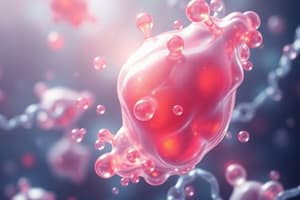Podcast
Questions and Answers
Which type of lipid is liquid at room temperature?
Which type of lipid is liquid at room temperature?
- Triglycerides
- Oils (correct)
- Sterols
- Phospholipids
What is the main characteristic that differentiates saturated fatty acids from unsaturated fatty acids?
What is the main characteristic that differentiates saturated fatty acids from unsaturated fatty acids?
- Solubility in water
- Number of double bonds (correct)
- Length of the carbon chain
- Presence of carbon chains
Which type of fatty acid is typically derived from fatty fish?
Which type of fatty acid is typically derived from fatty fish?
- Long chain fatty acids
- Medium chain fatty acids
- Short chain fatty acids
- Very long chain fatty acids (correct)
Which lipid is primarily known for forming biological membranes?
Which lipid is primarily known for forming biological membranes?
What is the typical range of carbon atoms in long chain fatty acids?
What is the typical range of carbon atoms in long chain fatty acids?
Flashcards
Lipids
Lipids
Organic compounds that contain carbon and are soluble in organic solvents, but not in water. Most are a mixture of saturated, monounsaturated, and polyunsaturated fatty acids.
Fats
Fats
Lipids that are solid at room temperature (25°C or 70°F).
Oils
Oils
Lipids that are liquid at room temperature (25°C or 70°F).
Fatty Acids
Fatty Acids
Signup and view all the flashcards
Carbon Chain Length
Carbon Chain Length
Signup and view all the flashcards
Study Notes
Lipids
- Lipids are organic carbon-containing compounds soluble in organic solvents but not in water.
- Many lipids are a mixture of SFA, MUFA, and PUFA.
- Fats are solid at room temperature (25°C or 70°F), while oils are liquid at room temperature.
- Triglycerides, phospholipids, and sterols are three types of lipids found in the body and food.
Fatty Acids
- Fatty acids differ in chain length.
- Most contain an even number of carbon atoms.
- Chain lengths include long chain (14-18 carbons), very long chain (20-24 carbons), medium (6-12 carbons), and short chains (<4 carbons).
- Fatty acids differ in degree of saturation.
- Saturated fatty acids contain only single bonds between carbon atoms.
- Unsaturated fatty acids contain double bonds.
- Fatty acids are named according to the location of double bonds, identified by the omega number (3,6,9).
Triglycerides
- Triglycerides are the primary form of fat in foods and the human body (95%).
- They consist of three fatty acid units attached to one glycerol unit.
- Triglycerides are formed through condensation reactions.
Phospholipids
- Phospholipids are similar to triglycerides but contain a phosphorus-containing acid in place of one fatty acid.
- Phospholipids are soluble in both water and fat.
- Phospholipids are important components of cell membranes.
- Lecithin is a common example.
Sterols
- Sterols are characterized by interconnected rings of carbon atoms with side chains of carbon, hydrogen, and oxygen.
- They play vital roles in vitamin D, sex hormones, and steroid hormones.
- Cholesterol is an example, found in animal products.
- Phytosterols are plant sterols that interfere with cholesterol absorption.
Lipid Stability
- Lipid stability is influenced by saturation.
- Polyunsaturated fats are more unstable due to double bonds.
- Strategies to protect lipids from becoming rancid include sealed containers, refrigeration, and antioxidants.
- Lipids undergo hydrogenation.
Hydrogenation & Trans Fatty Acids
- Hydrogenation protects against oxidation and alters the texture of lipids(liquids to solids).
- Most lipids become partially hydrogenated during processing.
- Some bonds change configuration from "cis" to "trans" during hydrogenation.
- Trans fatty acids have hydrogens on opposite sides of the double bond.
- Trans fats are mostly commercially produced.
Digestion of Lipids
- Lingual lipase digests milk fats in infants.
- Stomach fat floats as a top layer during digestion.
- Gastric lipase is responsible for some fat digestion.
- Pancreatic lipase breaks down fats into smaller parts for absorption
- Bile emulsifies fat to improve digestion by digestive enzymes.
- Small molecules diffuse into intestinal cells.
- Reassemble into triglycerides, forming chylomicrons.
Lipid Transport
- Lipoproteins transport lipids in watery blood.
- Chylomicrons, LDL, VLDL, and HDL are four types.
- Lower density = more lipid.
- Higher density = more protein.
Lipids in the Body
- Lipids provide concentrated energy, serving as fuel during aerobic exercise and a backup energy source in times of illness or poor intake.
- Lipids provide insulation, protect against shock, and help maintain cell membranes. – Lipids help with transportation of fat-soluble vitamins.
- Triglycerides store energy in adipose tissue.
- Adipose tissue secretes hormones (adipokines).
Essential Fatty Acids
- Linoleic acid (omega-6) is a component of membrane phospholipids and makes arachidonic acid.
- Alpha-linolenic acid (omega-3) is a component of membrane phospholipids and makes EPA and DHA
- Omega-3 and 6 are crucial for growth, vision, and brain development and function.
Lipid Metabolism
- Triglycerides from chylomicrons and VLDL are stored in adipose tissues
- Lipoprotein lipase plays a role in TG hydrolysis, once in the cell other enzymes can reassemble TG for storage.
- Glucose and fat are used together to provide energy, sparing protein
- 60% of energy needs are supplied from fat at rest.
- During exercise and periods of deprivation, fat's contribution increases.
- Hormone-sensitive lipase releases glycerol and fatty acids into the bloodstream, where cells can use them for energy during periods like fasting.
- Some protein breakdown is needed to support synthesis of CHO (in the absence of adequate CHO intake)
- Fatty acids can't be converted into glucose, only into CHO and glycerol from the TG molecule.
Health Effects & Recommended Intake
- High saturated and trans fats contribute to increased LDL ("bad" cholesterol) levels, raising risks for cardiovascular disease (CVD).
- Guidelines for healthy individuals suggest limiting total fat intake to 20-35% of calories, with reduced saturated and trans fats.
- A diet low in saturated and trans fats is often recommended to manage cholesterol, thus reducing cardiovascular disease risk.
- A regular blood lipid profile is essential to monitor levels and detect any abnormalities.
- Guidelines emphasize intake of foods with monounsaturated and polyunsaturated fats (MUFAs and PUFAs), and a sufficient amount of Omega 3.
- Individuals with a higher risk of cardiovascular disease may have different recommendations based on their unique risk factors or conditions.
Fat in the Diet and Fat Replacers
- Found in foods as visible fats (easy to remove) and invisible fats (marbled meats, processed meats & sauces).
- Foods with added fat include butter, margarine, oils, shortenings
- Hidden fat present in fried, baked goods, sauces.
- These dietary sources provide raw materials, taste, texture, appetite stimulation, satiety, and enhance food texture.
- Fat replacers offer taste and texture but reduce calories.
- Examples include olestra, which is poorly absorbed and may cause digestive discomfort.
Applying the Recommendations
- Lowering LDL cholesterol involves actions like choosing a diet with 20-35% of calories from fat, reduced saturated fat (<10% total kcals) and trans fat intake (<1%), whole foods over processed, and increasing intake of MUFAs and PUFAs.
- Increasing HDL cholesterol involves regular physical activity, a balanced diet, and moderate alcohol consumption.
- The dietary guidelines encourage eating plenty of fruits, vegetables, whole grains, nuts, and seeds and include fish 2x/ week.
- Considering the Mediterranean Diet is a healthy approach.
The Mediterranean Diet
- Contains olive oil.
- Includes nuts, offering nutrients like MUFAs, PUFAs, protein, fiber, and phytochemicals.
- Incorporates fish, emphasizing their importance as a source of nutrients, especially for pregnant women and children.
- Includes fresh, whole foods like fruits and vegetables, whole grains, and legumes.
- Promotes a limited intake of processed foods and moderates dairy, alcohol, and meat consumption.
Additional Topics
- General information regarding fats in meat, eggs, fish, dairy, grains, and vegetables is included.
Studying That Suits You
Use AI to generate personalized quizzes and flashcards to suit your learning preferences.




